#The Three Mothers
Text
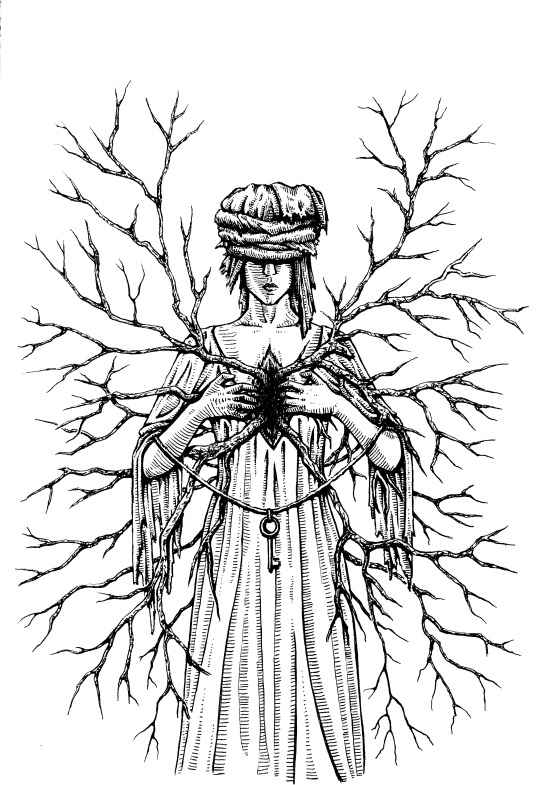
Mater Suspiriorum
In his book Suspiria De Profundis, Thomas De Quincey talks about the three Ladies of Sorrow. The second one is Mater Suspiriorum, Our Lady Of Sighs.
«The second sister is called Mater Suspiriorum , Our Lady of Sighs. She never scales the clouds, nor walks abroad upon the winds. She wears no diadem. And her eyes, if they were ever seen, would be neither sweet nor subtle; no man could read their story; they would be found filled with perishing dreams, and with wrecks of forgotten delirium. But she raises not her eyes; her head, on which sits a dilapidated turban, droops forever, forever fastens on the dust. She weeps not. She groans not. But she sighs inaudibly at intervals. (...) She also carries a key; but she needs it little.»
#mater suspiriorum#suspiria#our lady of sighs#suspiria de profundis#our ladies of sorrow#the three mothers#thomas de quincey#levana and our ladies of sorrow#suspiriorum#dark art#dark surrealism#dark fantasy#my art#art i made for my thesis#for the (not so) imaginary brand ignis domina#inspired heavily by the movie Suspiria (2018)#and the inside of human lungs
168 notes
·
View notes
Text







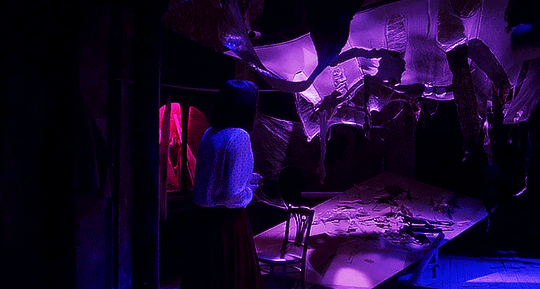


Inferno (1980) | Dir. Dario Argento
#inferno#inferno 1980#the three mothers#filmedit#filmgifs#horrorgifs#horroredit#movieedit#moviegifs#dailyfilm#junkfooddaily#giallo films#giallo#dario argento#gifs#film#my edit#my gifs#flashing gif warning
593 notes
·
View notes
Text
Prayers of The Three Mothers
(Mother of Sighs)
Dark Queen,
She who carries the sighs of the hopeless,
We gather as one in reverence.
We call on thee within in the endless darkness,
To release us from the mortal coil once our time has come,
so our sorrows may finally lift and melt away in the sun.
In life and in death,
We await your embrace.
Mother Suspiriorum
(Mother of Tears)
Weep for us,
Sorrowful mother.
Weep for the restless sleepers,
For your sisters who’s skins were blackened by burning flame,
Weep for those suffering from the cruelties of this world.
Let your cries fill the night sky,
And may your tears wash away the sorrows and doubts in our hearts.
Weep for us,
Mother Lachrymarum
(Mother of Darkness)
Defier of God,
Maiden of Lunacies,
Through your darkness, the true wicked ones are revealed,
Where those who are oppressed find sanctuary,
Mother of Outcasts,
Whatever path we may walk,
We return and rejoice in your shadows as we bless your name,
Mother Tenebrarum
(Combined Prayer)
Fear,
Darkness,
Sorrow,
Grant us mercy in this unforgiving world,
Nourish our souls with your tears in this blessed hour,
And breathe new life into us in which we are reborn.
Unholy Mothers,
Guide us with your hands and teach us to draw empathy from cruelty,
Kindness from hatred,
To embrace the shadows but never let them consume us.
Mater Tenebrarum
Mater Lachrymarum
Mater Suspiriorum
Hail the Three Mothers!

(Artwork not mine)
#the three mothers#mother of sighs#mother of tears#mother of darkness#suspiria#suspiria 2018#witches#Mater Tenebrarum#Mater Lachrymarum#Mater Suspiriorum#my prayers
15 notes
·
View notes
Photo
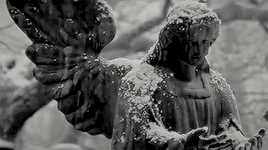





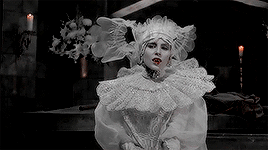

THE THREE MOTHERS: Mater Tenebrarum, Our Lady of Darkness.
“But the third sister, who is also the youngest! Hush! whisper whilst we talk of her! Her kingdom is not large, or else no flesh should live; but within that kingdom all power is hers. Her head, turreted like that of Cybèle, rises almost beyond the reach of sight. She droops not; and her eyes rising so high might be hidden by distance. But, being what they are, they cannot be hidden; through the treble veil of crape which she wears, the fierce light of a blazing misery, that rests not for matins or for vespers, for noon of day or noon of night, for ebbing or for flowing tide, may be read from the very ground. She is the defier of God. […] And her name is Mater Tenebrarum, Our Lady of Darkness.” – Thomas de Quincey, Suspiria de Profundis (x)
#the three mothers#dario argento#suspiria de profundis#suspiria#filmedit#inferno#mythology#mater tenebrarum#*#mine#my gifs
179 notes
·
View notes
Text

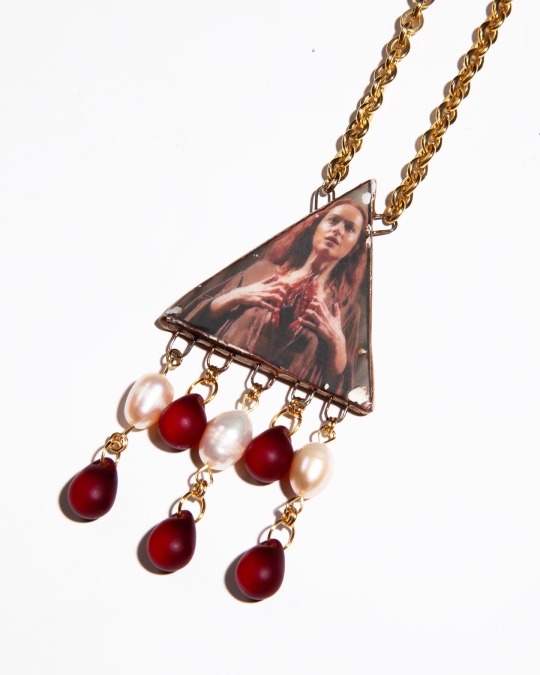
I Am She, Mother Suspiriorum, Suspiria-inspired, OOAK ceramic necklace.
SHOP.
#personal#the idol collective#suspiria#Mother Suspiriorum#Susie bannion#dakota johnson#horror jewelry#luca guadagnino#dario argento#ceramic jewelry#ceramics#horror movies#the three mothers
329 notes
·
View notes
Text
The Three Mothers
((A/N: thank you, @cactus-in-a-teacup, for listening to me few days ago as I hyped about Walsstino. You made me want to write something again.))
The world was first a dark void, from which First Mother and First Father came. She was force of creation, and he of destruction, and they couldn't exist without each other. Their violent dance created the planet, but they were tired. So they split into four entities each.
Mother split into Mothers of Sky, Stone, Sea and Flame, and Father split in their destructive equivalents. And the Mothers began creating, and the Fathers countered their efforts.
Years passed, decades, centuries even. The Mothers were growing more tired by the day, and agreed to create beings with a special spark that would take up their fights.
Mother of Sky was first, and she made the harpies. The Father of Sky fought them with storms and thunder, and hurricanes, but the Harpies prevailed.
Father of Flame grinned and whispered a word to Father of Sky, and from their will an enormous bird of prey took flight and hunted the harpies where they flew. To survive, harpies made their nests in the cliffs where Windmaster could not find them.
Mother of Stone saw how it was and created the Treefolk, to hide in the trees and spread the roots deep so birds above couldn't pick them. And for a while, it was good, for Father of Stone sent them earthquakes and droughts and landslides, but Treefolk prevailed.
Father of Flame grinned and whispered a word to Father of Stone, and from their will a being as large as the mountain grew from the ground with fire and rumble, and its fiery blood burned the treefolk and their forests. To survive, Treefolk cast their seed and hurried it growth, made it feed upon the blood that killed their ancestors.
Mother of Sea saw how it was and thought long. And she created mermaids, smart and fast and fiesty, with tails to navigate the seas and feet to run upon the shores, and voices so lovely they could enchant the birds. And the Father of Sea cast many calamities their way, whirpools and currents, and sharks and eels, and waves that could level a mountain, but mermaids prevailed.
Father of Flame grinned and whispered a word to Father of Sea, and from their will swam out a beast of tentacles and storms, and its roar poured terror into the mermaids. But the learned and adapted and were fast and avoided the great beast so well, the Fathers growled for the first time.
Mother of Flame saw it all and thought for a long time. Father of Flame was angry and was sure to unleash a monster unlike any other upon her children. So she cut her skin and used her flesh to create humans. She filled them with rage and swiftness and the fires of her soul, and breathed her last breath to make them able to create.
The Father of Flame saw this and was angry, and he burned the very earth they walked upon, but humans took the fire and tamed it, to cook their meats and warm them in cold nights. So the Father of Flame called upon the other Fathers to join their strengths. And the humans took the elements and tamed them. The stone became tools and farms. And water was lead to feed the farms, and humans build boats to sail upon the seas, and they used wind to push their boats from one island to another.
And Father of Flame grew angrier still.
He took the beasts from other Fathers and made them one, made them a Dragon. From the Windmaster, the Dragon got wings and claws and swiftness in the air. From Volcano, the Dragon got the scales harder than any stone and the fire in its veins and breath. And from the Kraken, the Dragon got wit and appetite and desire to hunt. And the Dragon hunted the humans, burned their crops and tore down their walls and the humans seemed done for.
But humans had the Flame in their soul and they thought and they created and built weapons and traps and took Dragon down, and cut through its scales with blades sharper than any claw. And they took its heart and used its beat to find Father of Flame. For centuries humans waged a war against him, and eventually won, and threw his body into the skies, where it still circles the world, bringing light and warmth.
And other Fathers saw this and they were angry, and they turned their great beasts at humans. And each beast humans defeated and used its heart to find the Fathers. And with each Father they waged a war, until ultimately humans won.
Father of Sea was sliced and chopped and cast across the sea, his bones jutting from the seas as stones.
Father of Sky had his lungs removed and sent to the four sides of the world, where his breath still causes the winds.
Father of Stone the humans buried in the ocean, his head and shoulders peeking above the sea and humans settled his body and named it Walsstino.
But Mothers saw this and were afraid. For what beings are those who can defeat the Fathers? And how can they be certain one day the humans wouldn't turn on them? So they struck a deal with humans, that they would make the world adapt under human hands as long as humans agreed not to hunt the mermaids, the harpies and the treefolk. And humans asked if they would care for the Flame of human souls until they would be ready to be reborn, and the three Mothers agreed. And the deal was made.
Mother of Sea would care for sailors and fishermen and any other who died in or above the sea, and the living she gifted with plentiful fish.
Mother of Sky took the diseased, after their bodies were burned into ash and the ashes thrown into winds, and the living she gifted with fresh water that rained from the skies.
And Mother of Stone took all others, as long as their body was buried with a seed, and the living she gifted with berries and fruits and herbs.
And though the Mothers are temperamental, they do hold on to their promise and humans hold on to theirs.
Or so say the Walsses.
#Walsstino#Walsstino worldbuilding#Worldbuilding#fantasy worldbuilding#The Three Mothers#creation myth
12 notes
·
View notes
Text

Inferno (1980)
2 notes
·
View notes
Text
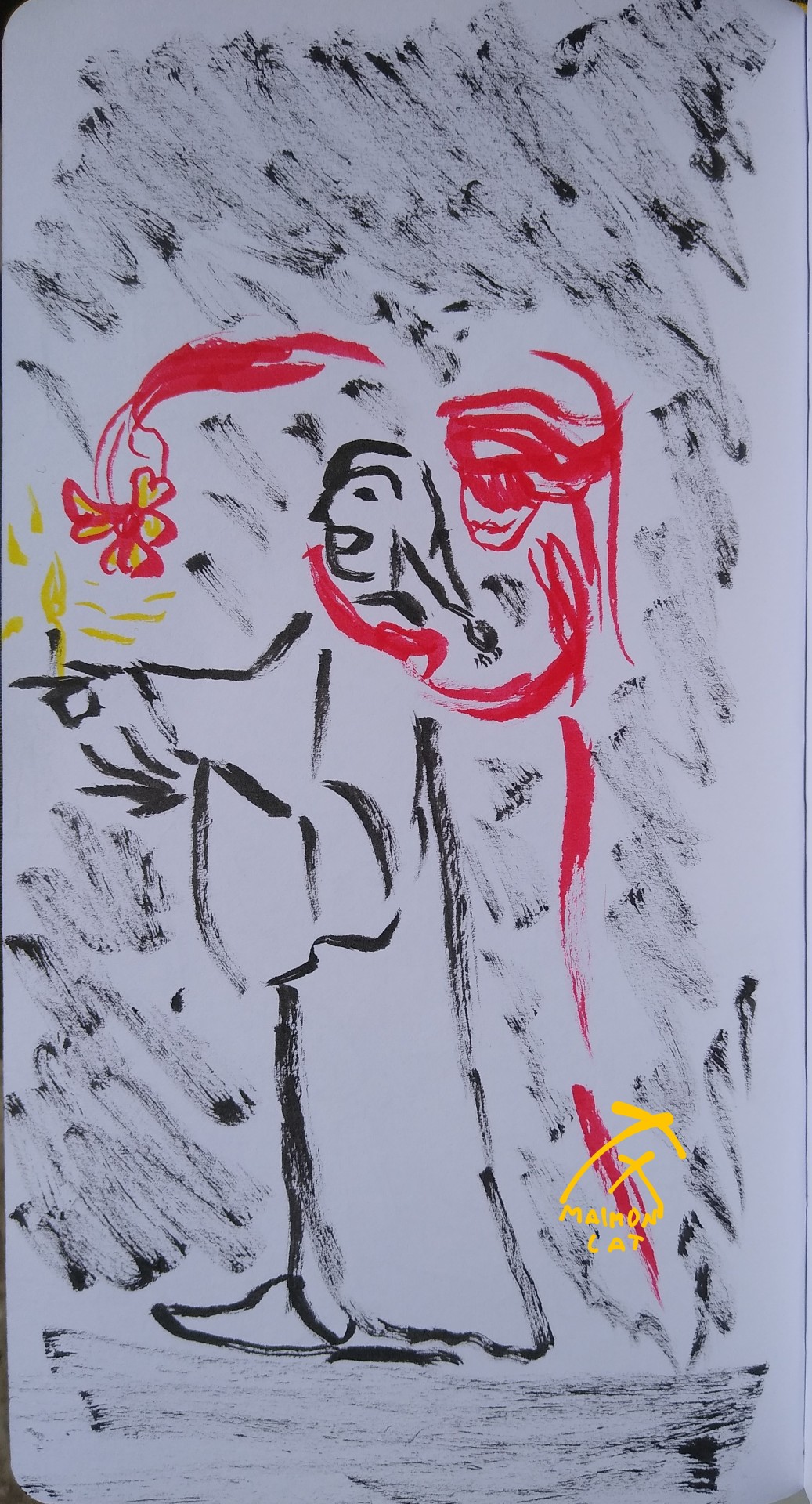
Happy Halloween, everyone. To celebrate this night of scares, I’m posting this “Suspiria” fanart here. I really love using these pens
#1529#Mater suspiriorum#suspiria#suspirium#Helena markos#Le tre madri#dario argento#suspiria 1977#italian horror#ink drawing#iris#die drei mütter#the three mothers#our ladies of sorrow#Le nostre signore del dolore#desiderius erasmus#my art#my artwork#haunted#haunting#haunted house#horror#razor
4 notes
·
View notes
Text
It will forever frustrate me that we will never know what the original "Mother of Tears" movie should have been like.
We all know that "Mother of Tears" was one of the most disappointing endings we could have to the Three Mothers trilogy, and that it clearly is not the movie originally intended to complete the set. Made thirty years too late, abandoning all the elements that united together the two first movies and made their strength, changing the actors, constantly cut and re-cut for a much smaller budget than originally anticipated, producers forcing explanations and call-backs everywhere... This third movie was a mess, and I do understand why people choose to consider the Three Mothers a duology rather than a trilogy.
But the thing is that the "true" Mother of Tears, the truly intended finale of the trilogy could have existed - and we have pieces of it left. Right as Inferno was being completed, "Mother of Tears" was in the work, and almost everything was ready to shoot it right after Inferno's release and complete the trilogy. There was a whole script prepared back then - a script which to my knowledge never got released. We could have had a movie that was a true sequel and conclusion to "Suspiria" and "Inferno", with the same techniques, same mindset, same actors, same aesthetic, and we could have had the complete triad. But it never came to pass, and it seems the original script will never saw the light of day... Unless it has and I had no knowledge about it.
The only piece of Internet I found that talked about what Mother of Tears could have been, and originally was supposed to be, is this article right here. And even then it is vague and allusive since again, the project was kept secret at the time (except for the name) and then once it was abandoned a first time the script never got released. Their best clues (as they explain in the article) is to look at the movies that might have been or clearly were influenced by the unnamed "Mother of Tears": Bava's Demons, Nicolodi's Da Profundis, Argento's Phenomena... And the best theory the article can push forward, due to the similarities between Da Profundis and Demons, is that the original Mother of Tears might have centered around the making or screening of a movie that ended up angering the Mother of Tears and bringing her supernatural wrath upon the world... But even then, that's a vague theory with coincidences to back it up.
Endless frustration will be my curse to not even know what the original conclusion was meant to be, and what was originally supposed to take the place of this laughable garbage movie we got.
5 notes
·
View notes
Text
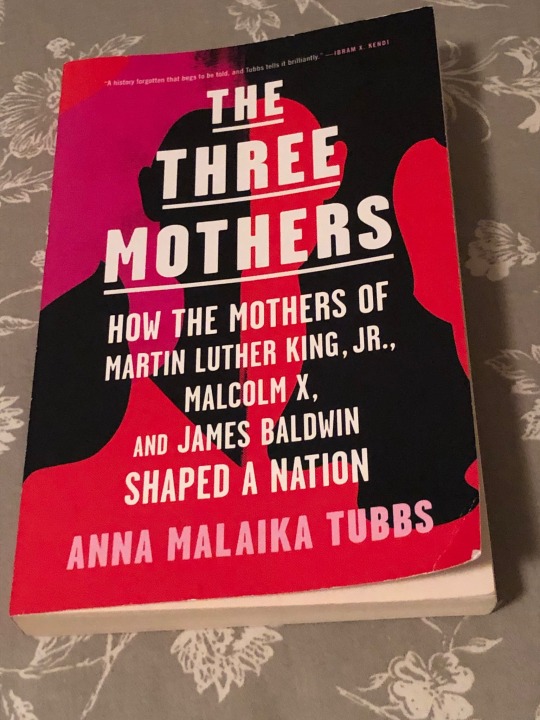
Truly fascinating book that links the lives of Berdis Baldwin, Alberta King, and Louise Little, and the impact each had on their sons, communities, and all of us.
#reading list#history#the three mothers#Alberta king#berdis Baldwin#Louise little#martin luther king jr#james baldwin#malcom x#Anna malaika tubbs
2 notes
·
View notes
Text

Mater Lachrymarum
In his book Suspiria De Profundis, Thomas De Quincey talks about the three Ladies of Sorrow. The first one is Mater Lachrymarum, Our Lady Of Tears.
«Her eyes are sweet and subtle, wild and sleepy, by turns; oftentimes rising to the clouds, oftentimes challenging the heavens. She wears a diadem round her head. (...) This sister, the elder, it is that carries keys more than papal at her girdle, which open every cottage and every palace. (...) By the power of her keys it is that Our Lady of Tears glides a ghostly intruder into the chambers of sleepless men, sleepless women, sleepless children, from Ganges to the Nile, from Nile to Mississippi.»
#mater lachrymarum#our lady of tears#suspiria#suspiria de profundis#our ladies of sorrow#levana and our ladies of sorrow#the three mothers#thomas de quincey#lachrymarum#dark art#dark surrealism#my art#traditional art#art i made for my thesis#for the (not so) imaginary brand ignis domina
63 notes
·
View notes
Quote
She would risk standing up to her husband, whom even she had to address as ‘Mr. Baldwin,' to ensure that Jimmy could follow his passion. She'd been kept from her own by her circumstances, and she would not let the same thing happen to her son.
The Three Mothers by Anna Malaika Tubbs
3 notes
·
View notes
Photo


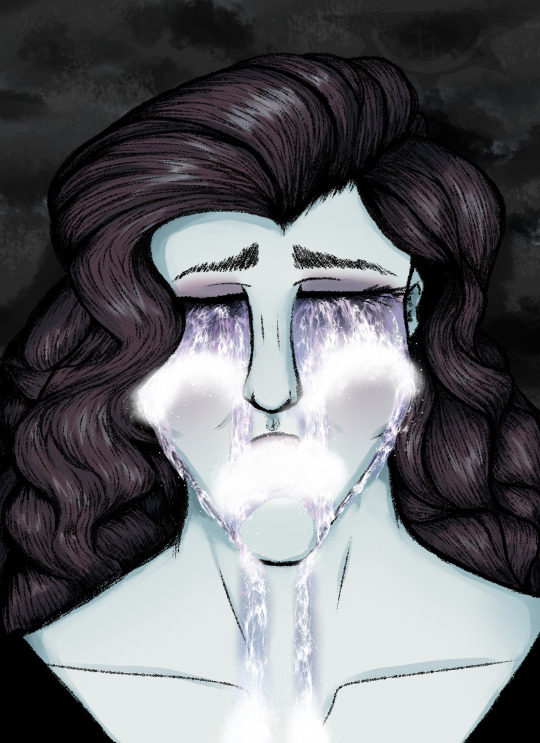
The Three Mothers
Suspiriorum, Tenebrarum, Lachrymarum
17 notes
·
View notes
Photo

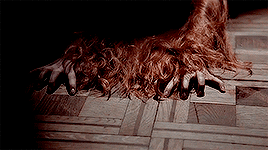

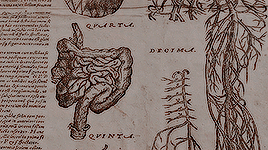



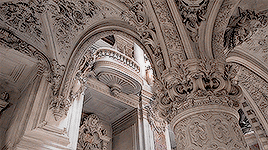
THE THREE MOTHERS: Mater Suspiriorum, Our Lady of Sighs.
“The second sister is called Mater Suspiriorum, Our Lady of Sighs. She never scales the clouds, nor walks abroad upon the winds. She wears no diadem. And her eyes, if they were ever seen, would be neither sweet nor subtle; no man could read their story; they would be found filled with perishing dreams, and with wrecks of forgotten delirium.” – Thomas de Quincey, Suspiria de Profundis (x)
#if someone had told me#that watching suspiria would trigger a life long obsession in me#i wouldn't have believed it#so anyway go watch the original and the 2018 version#because both are masterpieces of horror#the three mothers#dario argento#suspiria de profundis#suspiria#filmedit#suspiriaedit#mythology#mater suspiriorum#*#mine#my gifs
202 notes
·
View notes
Text
Therasia: Minoan Goddess of the Sun, Fire, and Daytime Sky
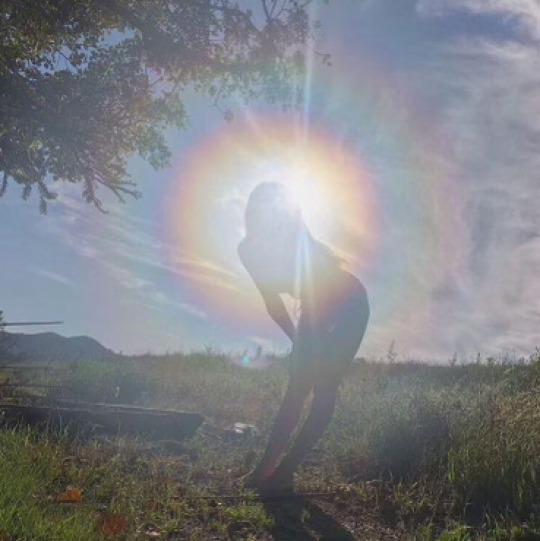
Who Is She?
Within the Modern Minoan Path (MMP), Therasia is one of the Three Mothers at the top of the pantheon. The Three Mothers are split into a triplicity: sky, land and sea. Therasia represented the sky.
The Minoan civilization is largely a mystery to us because their language is still undeciphered! So how did we get to know about Therasia? Well, Linear A is undeciphered, but Linear B is readable. Linear B was a later version of Linear A, and an early ancestor of Ancient Greek, that gives us some insight.
“At Knossos [a large “city” of Crete which could have functioned something like a capitol if we use today’s thinking], in a LMIIIA context (14th century BC), seven Linear B texts while calling upon "all the gods" make sure to grant primacy to an elsewhere-unattested entity called qe-ra-si-ja and, once, qe-ra-si-jo. However this probably refers to a god or a person rather than to an island *Qherasia > Therasia.” Wikipedia.
How do we know there even was a Sun Goddess? Well, unexpectedly, one of the biggest sources the MMP has drawn knowledge from has been folk dance/ethno-choreography from around the Aegean and eastern Mediterranean regions. Ethno-choreography is “not just the study or cataloguing of the thousands of external forms of dances—the dance moves, music, costumes, etc.— in various parts of the world, but the attempt to come to grips with dance as existing within the social events of a given community as well as within the cultural history of a community. Dance is not just a static representation of history, not just a repository of meaning, but a producer of meaning each time it is produced—not just a living mirror of a culture, but a shaping part of culture, a power within the culture:
“The power of dance rests in acts of performance by dancers and spectators alike, in the process of making sense of dance… and in linking dance experience to other sets of ideas and social experiences”.” Wikipedia https://en.wikipedia.org/wiki/Ethnochoreology
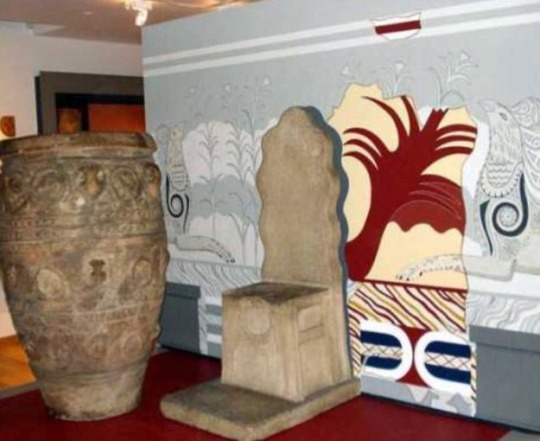
In many of these dances, there is honoring and implication of a Sun Goddess. In Knossos, there is a throne room just off the temple complex’s courtyard that implies this Goddess. A sun rising over the double-peaked sacred summit of Mt. Juktas flanked by palm trees and griffins, both things believed throughout the Mediterranean to be symbols of an ancient Sun Goddess. So whatever she might have been called in their native tongue, this Sun Goddess was obviously a sacred part of their religious practices.
These pieces of evidence and a collection of shared gnosis has led to the MMP understanding of Therasia.
How Therasia Differs From Other Sun Deity Traditions
We are used to thinking of the Sun as a masculine force in Hellenism and Wicca. However, before the Bronze Age Collapse, it seems the opposite was the norm. The Sun was a radiant woman, re-birthing herself yearly at the winter solstice. Personal experience and some shared gnosis has told me that while the Sun is a large part of her, she is not just this. She is the daytime sky, whether it is sunny with blue skies or dark and stormy. Rain, too, is her (though she shares this with the Serpent Mother). The nighttime sky, however, is our lady of stars Ourania. She may have also been regarded as the harbinger of the seasons. Many have encountered her as a powerful first contact when approaching Minoan spirituality.
While family trees are convenient and appealing in pantheons, as MMP founder Laura Perry puts it, the Minoan pantheon is more akin to a circus house of fun mirrors. However, Therasia is considered in MMP as the mother of Korydallos, god of joy, dance and humor, and Arachne, goddess of fate. Therasia and Korydallos may have been worshipped in a pair as Thumia and Kaulo in the form of hummingbird-lovers. (Mother-Son relationships among the gods was not considered incest, just a deity-thang).
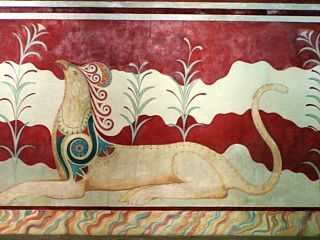
Eruption on Therasia
If you googled Therasia, you would find the island Therasia, the second largest island in the volcanic island group of Santorini in the Greek Cyclades. What are now the two islands, Therasia and Thera, was once one island, split by a volcanic eruption known as the Thera Eruption or the Minoan Eruption. I talk about the Thera Eruption because it was a contributing factor to the decline of Minoan Crete. Many palaces and coastal areas were destroyed. At the same time, there is evidence of invasion from Mycenaeans. It is also possible that the eruption spawned tsunamis which further decimated the island.
“The Minoan eruption was a major catastrophic volcanic eruption that devastated the Aegean island of Thera (also called Santorini) in around 1600 BCE. It destroyed the Minoan settlement at Akrotiri, as well as communities and agricultural areas on nearby islands and the coast of Crete with subsequent earthquakes and tsunamis… the eruption was one of the largest volcanic events on Earth in human history.
Although there are no clear ancient records of the eruption, its plume and volcanic lightning may have been described in the Egyptian Tempest Stele, and the ensuing volcanic winter coincides with a cold wave mentioned in the Chinese Bamboo Annals. Since tephra from the Minoan eruption serves as a marker horizon in nearly all archaeological sites in the Eastern Mediterranean, its precise date is of high importance and has been fiercely debated among archaeologists and volcanologists for decades, without coming to a definite conclusion.” Wikipedia https://en.wikipedia.org/wiki/Minoan_eruption
In the aftermath, I would be fascinated to know what myths the surviving Minoan people told to explain the series of tragedies and whether Therasia was any part of it as the namesake of the island that erupted. Especially since, allegedly, the eruption affected the coloration of the sunsets for three whole years. Additionally, some people think that this tragedy might have contributed to the myth of Atlantis.
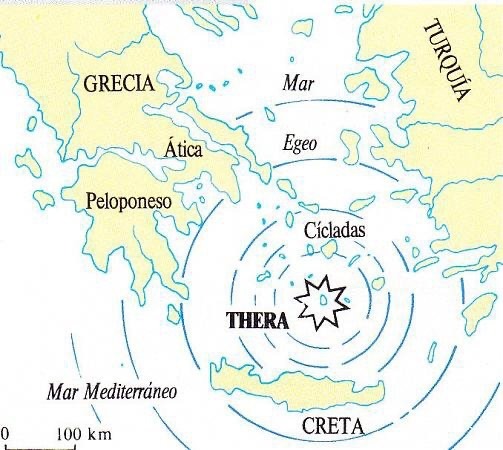
Associations:
☀️The Sun
☀️The Sun Wheel*
*(A perverted version of this symbol has been appropriated by Nazis so please be wary. It is still a sacred symbol but not all who use it use it in its original context. The Minoans were far from Aryan and have no support for the ideals of Nazism).
☀️Dates
☀️Date Palm Trees
☀️Griffins
☀️The Pillar, Pillar Imagery
☀️Figure of Eight Shields
☀️The Color Known As Phoenician Red/Tyrian Purple
☀️Yellow
☀️Saffron
☀️Sundays
☀️Electricity (a friend’s upg)
Ideas For Worship:
☀️Expanding your worldview
☀️Inspiration and creativity
☀️Connecting with the divine feminine
☀️Renewing your youthful spirit, as She does every winter solstice
☀️Fueling your inner strength and resilience
☀️Anything that needs passion, creativity, and/or vital energy
Ideas For Offerings:
☀️Water
☀️Fire
☀️Oil
☀️Honey
☀️Dates
☀️Figs
☀️Bread
☀️Milk
☀️”Scipy” scents (Cinnamon, ginger, frankincense)
☀️Relevant Imagery
☀️A Labrys
Divination:
I have found her to be open to tarot and pendulum; however, tarot wasn’t a favorite. Fire-based divination is a great fit. According to others I talk to, apparently any divination which involves reflection, reflection of the sun, is good to Her. White stones also seem to be a favorite for Her in the sense of geomancy/lithomancy or just as cult objects. One of the tarot cards I have come to associate with Her is the Page of Wands. I personally have a mirror dedicated to her from which I have received messages.

Devotional Poem
Fire of heaven,
Sun-mother,
Shine your radiance upon me.
As your power moves my spirit,
So your brilliance fills my heart
And warms me to my core.
Help me to stay seated in
The strength and passion
That is your gift to us
And to remember that
Your light shines within me, always.
- Laura Perry
☀️☀️☀️☀️☀️

Sources:
https://witchesandpagans.com/pagan-paths-blogs/the-minoan-path/the-minoan-sun-goddess-hail-therasia.html
https://en.wikipedia.org/wiki/Ethnochoreology
https://en.wikipedia.org/wiki/Minoan_eruption
https://www.livescience.com/4846-eruption-thera-changed-world.html
#therasia#minoan#mmp#sun goddess#bronze age#paganism#revivalist#deity#meet the minoans#sun#daytime#sky#sky goddess#divine feminine#griffin#saffron#the three mothers#minoan mothers#fire goddess#knossos#crete#ancient crete#cretan#ancient religions
10 notes
·
View notes
Photo
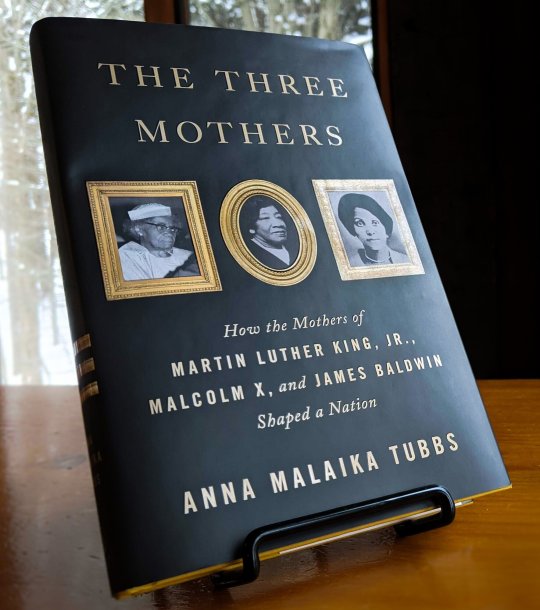
The latest read for our family’s Anti-Racism Book Club, and a book that was highly recommended by several friends, The Three Mothers is an eye-opening labor of love. In exploring and centering the lives and stories of Louise Little, Alberta King, and Berdis Baldwin, this book strives to remember these women in the context of their three influential families and to show the dramatic, international impact these woman had throughout their lives. Both through the ways in which they raised, nurtured, and taught their children, and in their direct activism work, these women have shaped the course of American history.
This book is a powerful refocusing of our lens onto three lives that have been little documented and under-celebrated. It is also engaging and a page-turner. These women lived such extraordinary lives—at times tragically sad, at times transcendently joyful—that they leap off the page. As someone who often struggles to make it through nonfiction, I sprinted through this book, riveted on every page, in awe of these women and their narratives. From the love Berdis maintained while interacting with her mentally-ill and abusive husband to Louise’s traumatic loss of her husband to deliberate and racist murder ruled as suicide, I was moved and horrified in turn to learn what these women had gone through. They were able to live and love in spite of so many hardships, undiminished by them.
The contrasts and comparisons among these women are artfully drawn. As author Anna Malailka Tubbs emphasizes, together the show a much more complex portrait of Black motherhood than they would alone. They experienced different socio-economic backgrounds, different frameworks of familial support, different environments and communities. They respond differently to the perils of their world, to decisions about marriages and careers, to trials of loss and change. Within these differences, they are empowered. They are active agents who shape their lives and their families, even when systems stand against them. The historical context this book provided was also illuminating. The time period examples of Black life during Jim Crow and segregation, the Great Migration, the impacts of the Great Depression and two World Wars, really helped me to see the forces of the time that shaped these women’s lives. The book did a wonderful job balancing awareness of the racism and sexism these women faced every single day, while centering these women as empowered individuals able to shape their futures and the futures of their children. This seemed, to me, like a difficult narrative balance to strike in crafting a book like this and it was powerfully done.
I felt this book breaking down some of my assumptions and biases as I read. Over the past few years, I have been increasingly attuned to narratives that are silenced—because of race, because of gender—but I could feel myself needing to deconstruct assumptions around motherhood and “traditional female roles” as I read. I do think I hold a set of “less than” assumptions about the pathway of being a wife/mother. I do think I have frowned upon women who give up their career to be a wife/mother primarily (despite, or perhaps because of, having seen my own mother do this.) I have frowned upon these women—not in terms of their choice��but out of some frustration at seeing brilliant women choose a life pathway that does not put their intellectual impacts in the public eye. I think I needed to tackle these assumptions in reading this book, appreciating in new ways how my long-held perspective is, too, a kind of silencing. Simply because wives/mothers’ contributions are not visible in the way I expect or hope for (and my expectations/hopes for “worth” and “impact” are absolutely those defined by the patriarchy) I was quicker to dismiss them. After reading this book, I have a new appreciation for the ways in which choosing motherhood is an inherently feminist act, one that does not bow to the demands of the patriarchy in terms of what “worth” and “impact” look like. I needed to examine myself as I read.
Beyond the strong anti-racism and anti-sexism work of the project of this book, beyond the thoughtful themes connecting and the history contextualizing these women, this book was a rewarding read on the level of my knowledge of these women’s stories. I could not believe that some of this information was new to me (Alberta King was assassinated?? Martin Luther King Jr’s brother A.D. also died under mysterious circumstances??) I was shocked that this was information I had never heard before about the King family, and I shared it with my dad, both of us exclaiming in confusion about how essential this information seemed to the narrative of MLK’s life, context, and battle for racial equality. Even in telling the stories of MLK’s life (let alone the life of Alberta King herself), we have received such a fragmented picture, a picture that highlights certain details and completely erases other essential events. These specific examples about the lives of the King family—two of many such examples about the lives of all three families—struck me as I read this book with a heavy appreciation of my blindness, born of deliberate erasure and prioritizing particular narratives in the education I have received. I want to work to counteract this. It takes a lot of work because the narratives and assumptions we hold are so strongly engrained.
#The Three Mothers#Anna Maliaka Tubbs#important reading#social justice#civil rights#Black experience#intersectional feminism#13/26 books
2 notes
·
View notes